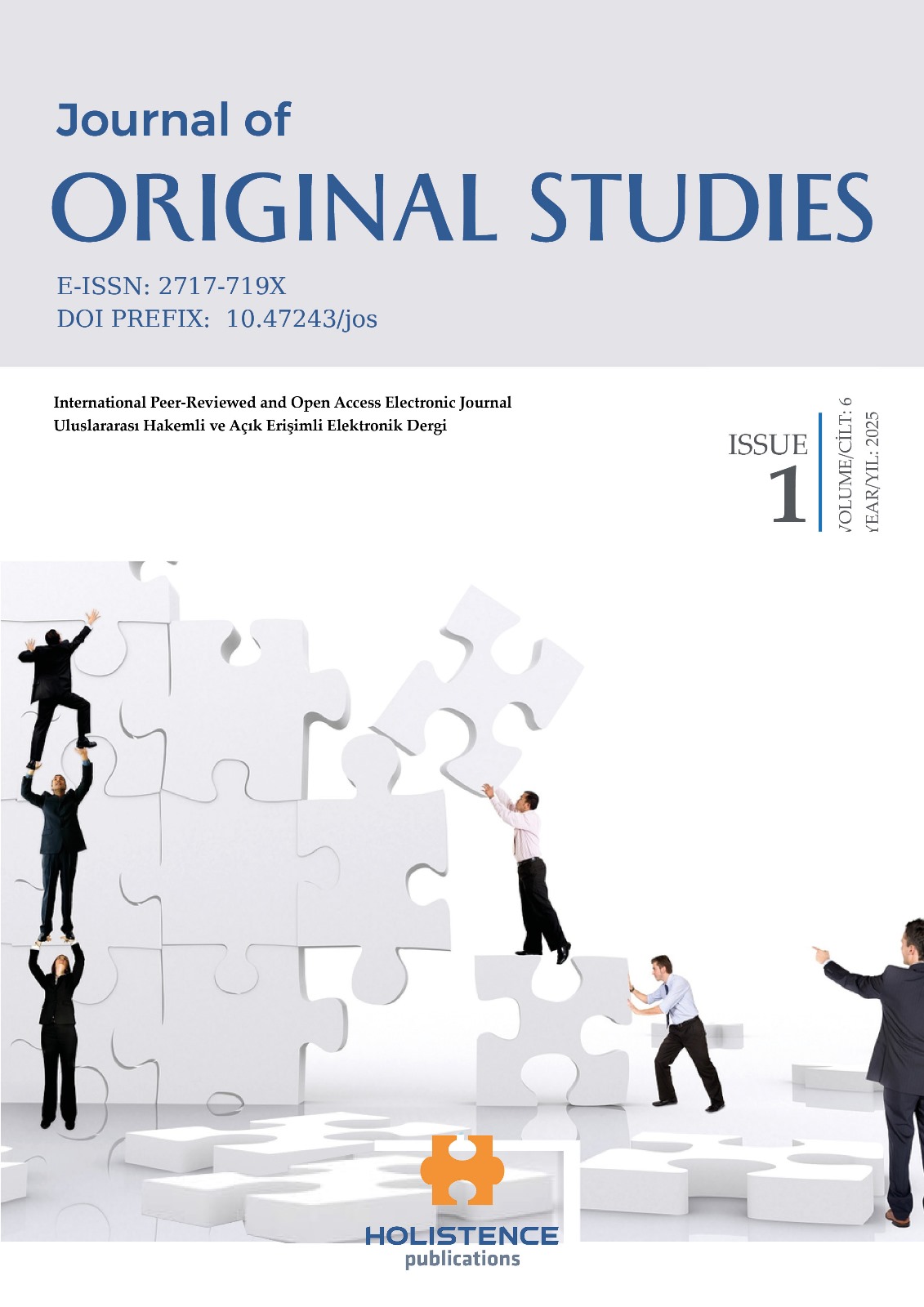Navigating organizational culture: The impact on cognitive dissonance, satisfaction, and well-being of Turkish workers
DOI:
https://doi.org/10.47243/jos.2725Keywords:
Adhocracy Culture, Cognitive Dissonance, Employee Satisfaction, Employee Well-being, Hierarchy CultureAbstract
The study’s purpose is to understand the influence of two culture types - Hierarchy Culture (HC) and Adhocracy Culture (AC)—on employee outcomes - cognitive dissonance (CD), employee satisfaction (ES), and employee well-being (EWB). The aim of the research is to understand these dynamics especially in Turkish organizations to provide managerial insights that minimizes negative outcomes for employees. A self-administered questionnaire was used to gather data from 380 participants working in Türkiye. After collecting data, statistical analyses such as Cronbach’s alpha, t-tests, ANOVA, correlation, and regression analysis were employed to explore the relationship between the variables. Findings indicate that HC has a strong positive relationship with cognitive dissonance, however, it has a weak positive relationship with employee satisfaction and well-being. Whereas AC shows a moderate negative relationship with cognitive dissonance and a moderate positive relationship with employee satisfaction. Moreover, AC also demonstrates a weak negative effect on employee well-being. The results suggest that hierarchical cultures may contribute to psychological discomfort, but it also increases levels of satisfaction and wellbeing. This could be due to HC’s ability to offer predictability. In contrast, AC fosters a flexible culture which reduces CD but may result in uncertainty which can lead to stress. These results offer valuable insight into the dynamics of Turkish workplaces. The importance of aligning organizational cultures with employee expectations to enhance productivity and wellbeing of the employees can be seen through the findings.
Downloads
References
ALEHEGN, D. (2023). The Effect of Organizational Culture on Employee Job Satisfaction in Kaizen Excellence Centre. Asian Journal of Engineering, Social and Health, 2(12), 1745-1755.
ALKHODARY, D. A. (2023). Exploring the relationship between organizational culture and well-being of educational institutions in Jordan. Administrative Sciences, 13(3), 92.
AUGUSTIN, S. (2022) Designing Workplaces to Align with Culture (s). TWR Transdisciplinary Workplace Research Conference 2022.
AWASTHY, R., & GUPTA, R. K. (2015). A cultural paradox in organisations in India. International Journal of Indian Culture and Business Management, 10(4), 391-408.
BELIAS, D., & KOUSTELIOS, A. (2014). Organizational culture and job satisfaction: A review. International review of management and marketing, 4(2), 132-149.
BELIAS, D., KOUSTELIOS, A., VAIRAKTARAKIS, G., & SDROLIAS, L. (2015). Organizational culture and job satisfaction of Greek banking institutions. Procedia-Social and Behavioral Sciences, 175, 314-323.
CAMERON KIM, S., & QUINN ROBERT, E. (1999). Diagnosing and changing organizational culture. Prantice Hall.
ELLINAS, C., ALLAN, N., & JOHANSSON, A. (2017). Dynamics of organizational culture: Individual beliefs vs. social conformity. PloS one, 12(6), e0180193.
FATIMA, M. (2016). The impact of organizational culture types on the job satisfaction of employees. Sukkur IBA journal of management and business, 3(1), 13-32.
FELIPE, C. M., ROLDÁN, J. L., & LEAL-RODRÍGUEZ, A. L. (2017). Impact of organizational culture values on organizational agility. Sustainability, 9(12), 2354.
FESTINGER, L. (1962). Cognitive dissonance. Scientific American, 207(4), 93-106.
FRANCO, M., SARTOR, R., & RODRIGUES, M. (2024). Cameron and Quinn’s organisational culture traits in the context of university-SME cooperation: A qualitative study. Industry and Higher Education, 09504222241289817.
GREGORY, K. (2011). The importance of employee satisfaction. The Journal of the Division of Business & Information Management, 5, 29-37.
HARRIS, K. (2021, December 23). IBM’s 6-point wellness program leans on tech prowess to generate engagement and results. Ragan Communications. https://www.ragan.com/ibms-6-point-wellnessprogram-leans-on-tech-prowess-to-generateengagement-
and-results/
HINOJOSA, A. S., GARDNER, W. L., WALKER, H. J., COGLISER, C., & GULLIFOR, D. (2016). A review of cognitive dissonance theory in management research: Opportunities for further development. Journal of Management, 43(1), 170-199.
HUSSAIN, M. A., & CHAUHAN, M. R. (2024). Evolving Approaches to Employee Retention in Changing Workforce Dynamics. International Journal of Advance and Applied Research. Vol, 11, No, 4.
IQBAL, S., GUOHAO, L., & AKHTAR, S. (2017). Effects of job organizational culture, benefits, salary on job satisfaction ultimately affecting employee retention. Review of Public Administration and Management, 5(3), 1-7.
KANDA, J. & FADZAI, R. (2022). The Role of Employee Well-Being in Business Success. Metropolia University of Applied Sciences.
KARACAY, G., BAYRAKTAR, S., KABASAKAL, H., & DASTMALCHIAN, A. (2019). Role of leaders as agents of negotiation for counterbalancing cultural dissonance in the Middle East and North Africa region. Journal of International Management, 25(4), 100704.
KREKEL, C., WARD, G., & DE NEVE, J. E. (2019). Employee wellbeing, productivity, and firm performance. Saïd Business School WP, 4.
LEE, K., KIM, Y., & CHO, W. (2018). A study on the relationship between servant leadership, organizational culture, and job satisfaction in fitness clubs. Sport Mont, 16(3), 43–49. https://doi.org/10.26773/smj.181008
LIKER, J. K. (2004). The Toyota Way: 14 Management Principles from the World’s Greatest Manufacturer McGraw-Hill Education.
LOCKE, E. A. (1970). Job satisfaction and job performance: A theoretical analysis. Organizational behavior and human performance, 5(5), 484-500.
McCord, P. (2014). How Netflix reinvented HR. Harvard Business Review. Retrieved from https://hbr.org/2014/01/how-netflix-reinvented-hr
MUSHTAQUE, T., & SIDDIQUI, D. A. (2019). Impact of organizational culture on job stress and employee engagement in Pakistan. Available at SSRN 3510644.
OLYNICK, J. P. (2016). Organizational culture and its relationship with employee stress, productivity, and enjoyment of work (Doctoral dissertation), University of Northern British Columbia.
O’NEILL, J. W., BEAUVAIS, L. L., & SCHOLL, R. W. (2001). The use of organizational culture and structure to guide strategic behavior: An information processing perspective. Journal of Behavioral and Applied Management, 2(2), 131–149.
SEHİĆ–KRŠLAK, S. (2021). The role of leadership in creating an organizational culture. Journal of Ekonomi, 3(1), 24-26.
SUMTER, K. (2016). The mediating role of psychological empowerment in the relationship between organizational culture and job-related affective well-being (Unpublished Dissertation). Tilburg University, Netherlands.
SUMTER, K. (2016). The mediating role of psychological empowerment in the relationship between organizational culture and job-related affective well-being (Unpublished Dissertation). Tilburg University, Netherlands.
SUN, S. (2008). Organizational culture and its themes. International Journal of Business and Management, 3(12), 137-141.
TAŞKIRAN, E., ÇETİN, C., ÖZDEMİRCİ, A., AKSU, B., & İSTORİTİ, M. (2017). The effect of the harmony between organizational culture and values on job satisfaction. International Business Research, 10(5), 133- 147.
THOMAS, S., & KARODİA, A. M. (2014). Human Resources Practices at Google in Terms of Some Management Perspectives: Exploring the Entrepreneurial Spirit. Arabian Journal of Business and Management Review (Nigerian Chapter) Vol, 2, 15-27.
WARRİCK, D. D. (2017). What leaders need to know about organizational culture. Business Horizons, 60(3), 395-404.
WOLFF, M. F. (1990). BUILDING CAREERS AT PROCTER & GAMBLE. Research Technology Management, 33(5), 9–11. http://www.jstor.org/stable/24125134
ZHANG, L., & WANG, Y. (2021). Impact of creative talents’ organizational culture consent on job satisfaction. South
Downloads
Published
How to Cite
Issue
Section
License
Copyright (c) 2025 Holistence Publications

This work is licensed under a Creative Commons Attribution 4.0 International License.
When the article is accepted for publication in the Journal of Orijinal Studies, authors transfer all copyright in the article to the Holistence Academy Ar-Ge Yazılım Yayıncılık Eğitim Danışmanlık ve Organizasyon Ticaret Ltd. Şti.The authors reserve all proprietary right other than copyright, such as patent rights.
Everyone who is listed as an author in this article should have made a substantial, direct, intellectual contribution to the work and should take public responsibility for it.
This paper contains works that have not previously published or not under consideration for publication in other journals.














